国际会计准则第36号
《企业会计准则》第 36 号
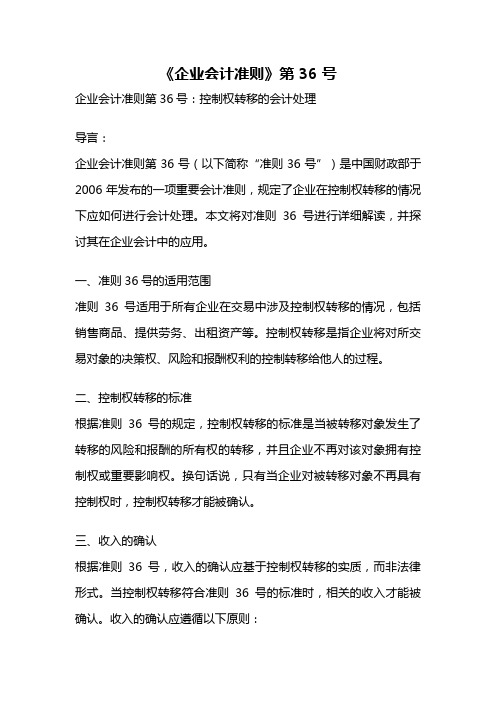
《企业会计准则》第 36 号企业会计准则第36号:控制权转移的会计处理导言:企业会计准则第36号(以下简称“准则36号”)是中国财政部于2006年发布的一项重要会计准则,规定了企业在控制权转移的情况下应如何进行会计处理。
本文将对准则36号进行详细解读,并探讨其在企业会计中的应用。
一、准则36号的适用范围准则36号适用于所有企业在交易中涉及控制权转移的情况,包括销售商品、提供劳务、出租资产等。
控制权转移是指企业将对所交易对象的决策权、风险和报酬权利的控制转移给他人的过程。
二、控制权转移的标准根据准则36号的规定,控制权转移的标准是当被转移对象发生了转移的风险和报酬的所有权的转移,并且企业不再对该对象拥有控制权或重要影响权。
换句话说,只有当企业对被转移对象不再具有控制权时,控制权转移才能被确认。
三、收入的确认根据准则36号,收入的确认应基于控制权转移的实质,而非法律形式。
当控制权转移符合准则36号的标准时,相关的收入才能被确认。
收入的确认应遵循以下原则:1. 收入应当与销售商品或提供劳务的风险和报酬的转移相一致;2. 收入应当能够可靠地计量;3. 收入的发生时间应当能够确定。
四、控制权转移的时间准则36号规定,控制权的转移时间是指企业不再对被转移对象具有控制权的时间点。
通常情况下,控制权转移的时间应当与风险和报酬的转移相一致。
但在某些情况下,控制权的转移时间可能与风险和报酬的转移时间不完全一致,此时应当根据实际情况进行判断。
五、控制权转移后的会计处理准则36号规定,控制权转移后,企业应根据所涉及交易的性质和特点,正确处理相关的会计事项。
具体会计处理的要点如下:1. 销售商品的控制权转移后,应确认销售收入,并计提相应的销售成本;2. 提供劳务的控制权转移后,应确认劳务收入,并计提相应的劳务成本;3. 出租资产的控制权转移后,应确认租赁收入,并计提相应的租赁成本。
六、其他会计处理事项准则36号还规定了其他几类特殊情况下的会计处理事项,包括回购、转让回购、租赁回购等。
国际会计准则第36号 资产减值【外文翻译】
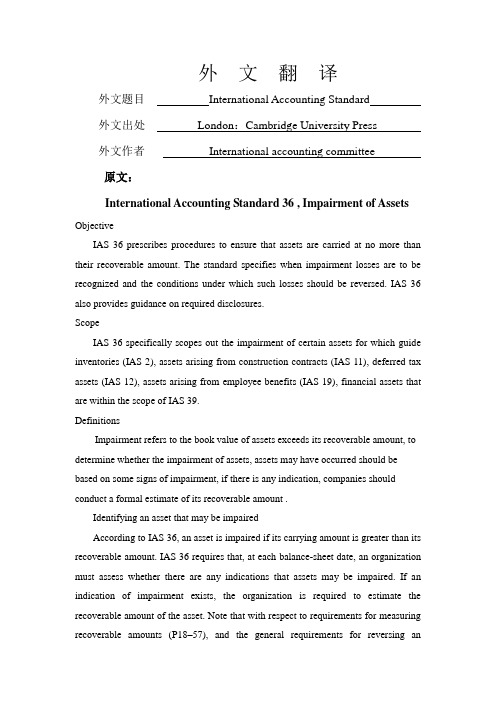
外文翻译外文题目International Accounting Standard外文出处London:Cambridge University Press外文作者International accounting committee原文:International Accounting Standard 36 , Impairment of Assets ObjectiveIAS 36 prescribes procedures to ensure that assets are carried at no more than their recoverable amount. The standard specifies when impairment losses are to be recognized and the conditions under which such losses should be reversed. IAS 36 also provides guidance on required disclosures.ScopeIAS 36 specifically scopes out the impairment of certain assets for which guide inventories (IAS 2), assets arising from construction contracts (IAS 11), deferred tax assets (IAS 12), assets arising from employee benefits (IAS 19), financial assets that are within the scope of IAS 39.DefinitionsImpairment refers to the book value of assets exceeds its recoverable amount, to determine whether the impairment of assets, assets may have occurred should be based on some signs of impairment, if there is any indication, companies should conduct a formal estimate of its recoverable amount .Identifying an asset that may be impairedAccording to IAS 36, an asset is impaired if its carrying amount is greater than its recoverable amount. IAS 36 requires that, at each balance-sheet date, an organization must assess whether there are any indications that assets may be impaired. If an indication of impairment exists, the organization is required to estimate the recoverable amount of the asset. Note that with respect to requirements for measuring recoverable amounts (P18–57), and the general requirements for reversing animpairment loss (P109–116), the standard uses the term “assets”; notwithstanding, the requirements apply both to individual assets and to cash-generating units.Fair value less costs to sellParagraphs 25 to 29 provide guidance on determining an asset’s fair value les s costs to sell.Paragraph 25 states “the best evidence of an asset’s fair value less costs to sell is a price in a binding sale agreement in an arm’s length transaction, adjusted for incremental costs that would be directly attributable to the disposal o f the asset.” In the absence of a binding sales agreement, for an asset that is traded in an active market, fair value less costs to sell is the asset’s market price less the costs of disposal. If there is no active market for the asset, the entity uses the best information available. Value in useTo estimate the value in use of an asset, an entity first estimates the future net cash flows to be derived from the asset’s use and ultimate disposal, and then applies the appropriate discount rate to those future cash flows.Paragraph 30 stipulatesthe following elements shall be reflected in the calculation of an asset’s value in use(a) an estimate of the future cash flows the entity expects to derive from the asset;(b) expectations about possible variations in the amount or timing of those future cash flows;(c) the time value of money, represented by the current market risk-free rate of interest;(d) the price for bearing the uncertainty inherent in the asset; and(e) other factors, such as illiquidity, that market participants would reflect in pricing the future cash flows the entity expects to derive from the asset. Estimates of future cash flows include (P39 and 52)a)projections of cash inflows from the continuing use of the assetb) projections of cash outflows incurred to generate the inflows from continuinguse that can be directly attributed, or allocated on a reasonable and consistent basis, to the assetc) net cash flows, if any, to be received (or paid) for the disposal of the asset at the end of its useful life (the amount that an entity expects to obtain from the disposal of the asset in an arm’s-length transaction between knowledgeable, willing parties, after deducting the estimated costs of disposal)The discount rates used to determine value in use must be pre-tax rates that reflect both the time value of money and the risks specific to the asset for which the future cash flow estimates have not been adjusted (P55).Cash flow projections should be based on reasonable and supportable assumptions about the economic conditions that will exist over the remaining useful life of the asset, with greater weight being given to external evidence. An entity should use the most recent budgets and forecasts, which are presumed to not go beyond five years. Beyond five years, an entity extrapolates from the earlier budgets, using a steady or declining growth rate not to exceed the long-term average growth rate for the products, industries, or countries in which.Paragraph 34 requires that management examine the causes of differences cash-flow projections and actual cash flows current cash-flow projections are based are consistent with past actual outcomes. Estimates of future cash flows exclude cash flows that relate to:future restructurings to which the entity is not yet committed (P44) improving or enhancing the asset’s performance (P44) financing activities (P50) income tax receipts or payments (P50)Recognizing and measuring an impairment lossIndividual assets other than goodwillFor individual assets other than goodwill, the requirements are laid out in paragraphs 58 to 64. An impairment loss must be recognized whenever an asset’s recoverable amount is less than its carrying amount (P59). Paragraph 60 requires that the impairment loss be recognized immediately as an expense in the income statement, subject to one exception, asset is carried at a revalued amount inaccordance with another standard. For asset is accounted for under the revaluation model in IAS 16 Property, Plant and Equipment or IAS 38 Intangible Assets, any impairment loss of the revalued asset would be treated as a revaluation decrease in accordance with that other standard. After the recognition of an impairment loss, the amortization expense for the asset is adjusted in future periods to allocate the asset’s revised carrying amount, less its residual value (if any), on a systematic basis over its remaining useful life (P63).Cash-generating unitsRecoverable amounts should be estimated for individual assets, if possible. However, if it is not possible, an entity must determine the recoverable amount of the cash-generating unit to which the asset belongs (P66). To begin this process, judgment is used to determine the smallest group of assets that generates cash inflows that are largely independent of the cash inflows from other assets or groups of assets. Once the asset’s cash-generating unit has been determined, the recoverable amount of the cash-generating unit is estimated based on the guidance already discussed. To determine how to define cash-generating units, an entity considers various factors including how management monitors the entity’s operations (such as by product lines or geographic areas) or how they make decisions about continuing or disposing of the entity’s assets and operations. If an active market exists for the output produced by an asset or group of assets, that asset or group of assets is identified as a cash-generating unit (P70).Paragraph 72 requires that cash-generating units be “identif ied consistently from period to period for the same asset or types of assets, unless a change is justified.”GoodwillIAS 36 acknowledges that goodwill acquired in a business combination sometimes cannot be allocated on a non-arbitrary basis to individual cash-generating units, but only to groups of cash-generating units. This is reflected in paragraph 80, which requires goodwill to be allocated to each of the acquirer’s cash-generating units (or groups of cash-generating units) that are expected to benefit from the synergies of the business combination, regardless of whether other assets or liabilities of theacquire are assigned to those units (or groups of units). Each unit (or group of units) to which the goodwill is allocated must represent the lowest level at which the goodwill is monitored for internal management purposes. In addition, the unit (or group of units) cannot be larger than an operating segment determined under IFRS 8 Operating Segments.Paragraph 90 specifies that a cash-generating unit to which goodwill has been allocated must be tested for impairment annually, and whenever there is an indication of potential impairment. If the recoverable amount of the unit exceeds its carrying amount, the unit and the goodwill allocated to that unit are considered not to be impaired. However, if the carrying amount of the unit exceeds the recoverable amount of the unit, the entity must recognize an impairment loss.Note that the impairment testing of cash-generating units must also consider the corporate assets that can be allocated to the cash-generating unit or group of units under review, as specified in paragraph 102. Corporate assets are assets other than goodwill that do not generate cash inflows independently of other assets or groups of assets and their carrying amount cannot be fully attributed to the cash-generating unit under review. Examples would include group or divisional assets such as a headquarters or divisional building, EDP equipment, or a research centre.The impairment loss on a cash-generating unit is allocated to reduce the carrying amount of the assets of the unit (or group of units) in the following manner (P104): first, reduce the carrying amount of any goodwill that was allocated to the unit (or group of units)second, reduce the carrying amounts of the other assets of the unit (or group of units) pro rata on the basis of the carrying amount of each asset These reductions in carrying amounts are recognized in the same way as impairment losses on individual assets (that is, in accordance with paragraph 60, discussed above). When allocating an impairment loss to the assets in a cash-generating unit, the carrying amount of an asset should not be reduced below the highest of its fair value less costs to sell (if determinable), its value in use (if determinable), and zero. The amount of any unallocated impairment loss that results is applied pro rata to the other assets of theunit (group of units) (P105).Reversal of an impairment lossReversal of an impairment loss for goodwill is prohibited (P124). The logic behind this relates to the fact that if goodwill has previously been impaired and then is regenerated, it is essentially “new” goodwill. This would be considered an internally generated intangible. which cannot be recognized as per IAS 38.For assets or cash-generating units other than goodwill, the requirements for reversing a previously recognized impairment loss follow the same approach as for the identification of impairments. At the end of each reporting period, the entity assesses whether there is an indication that an impairment loss may no longer exist, or may have decreased. Paragraph 1 specifies the minimum external and internal sources of information that are to be considered in assessing the potential of reversal in impairment; these factors parallel those that were listed under paragraph 12 to originally assess whether there has been an impairment loss (for example, changes in market value, environment or interest rates, or better than expected performance).If a potential reversal in impairment is indicated, the recoverable amount of the asset or unit is estimated (P110). If there has been a change in the estimates used to determine the asset’s recoverable amount since the last impairment loss was recognized, the carrying amount of the asset is increased to its recoverable amount (P114). However, the increased carrying amount of an individual asset due to reversal should not be more than the carrying amount that would have been determined (net of amortization) if no impairment loss had been recognized for the asset in prior years (P117).Paragraph 119 requires that the reversal of an impairment loss be recognized immediately a income in the income statement unless the asset is carried at a revalued amount in accordant with another standard (consistent with the treatment of impairment losses, the reversal of such a loss is treated as a revaluation increase in accordance with that other standard). After a reversal of an impairment loss is recognized, amortization is adjusted for future periods (P121).A reversal of an impairment loss for a cash-generating unit is allocated to the assets ofthe unit, other than goodwill, pro rata with the carrying amounts of those assets. These increase in carrying amounts are treated in the same manner as reversals of impairment losses for individual assets (that is, recognized in accordance with paragraph 119) (P122).When allocating a reversal of an impairment loss to the assets in a cash-generating unit, the carrying amount of an asset should not be increased above the lower of its recoverable amount (if determinable) and the carrying amount that would have been determined (net of amortization) if no impairment loss had been recognized for the asset in prior periods. The amount of any unallocated amount that results is applied pro rata to the other assets of the u (except for goodwill) (P123).As a final point in this section, paragraph 116 explains that an asset’s value in use may become greater than its carrying amount simply because the present value of future cash inflows increases as they become closer. However, the service potential of the asset hasn’t changed and, accordingly, no reversal of impairment is recognized based on this “unwindin g of discount.”Foreign source:London:Cambridge University Press,2008 :140-155译文:国际会计准则第36号资产减值(一)目的本准则的目的是,规定企业用以确保其资产以不超过可收回价值的金额进行计量的程序。
《企业会计准则第36号-关联方披露》
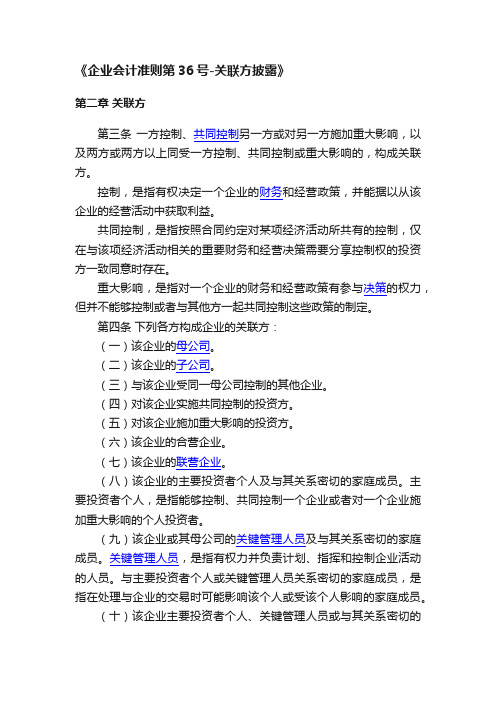
《企业会计准则第36号-关联方披露》第二章关联方第三条一方控制、共同控制另一方或对另一方施加重大影响,以及两方或两方以上同受一方控制、共同控制或重大影响的,构成关联方。
控制,是指有权决定一个企业的财务和经营政策,并能据以从该企业的经营活动中获取利益。
共同控制,是指按照合同约定对某项经济活动所共有的控制,仅在与该项经济活动相关的重要财务和经营决策需要分享控制权的投资方一致同意时存在。
重大影响,是指对一个企业的财务和经营政策有参与决策的权力,但并不能够控制或者与其他方一起共同控制这些政策的制定。
第四条下列各方构成企业的关联方:(一)该企业的母公司。
(二)该企业的子公司。
(三)与该企业受同一母公司控制的其他企业。
(四)对该企业实施共同控制的投资方。
(五)对该企业施加重大影响的投资方。
(六)该企业的合营企业。
(七)该企业的联营企业。
(八)该企业的主要投资者个人及与其关系密切的家庭成员。
主要投资者个人,是指能够控制、共同控制一个企业或者对一个企业施加重大影响的个人投资者。
(九)该企业或其母公司的关键管理人员及与其关系密切的家庭成员。
关键管理人员,是指有权力并负责计划、指挥和控制企业活动的人员。
与主要投资者个人或关键管理人员关系密切的家庭成员,是指在处理与企业的交易时可能影响该个人或受该个人影响的家庭成员。
(十)该企业主要投资者个人、关键管理人员或与其关系密切的家庭成员控制、共同控制或施加重大影响的其他企业。
第五条仅与企业存在下列关系的各方,不构成企业的关联方:(一)与该企业发生日常往来的资金提供者、公用事业部门、政府部门和机构。
(二)与该企业发生大量交易而存在经济依存关系的单个客户、供应商、特许商、经销商或代理商。
(三)与该企业共同控制合营企业的合营者。
第六条仅仅同受国家控制而不存在其他关联方关系的企业,不构成关联方。
第三章关联方交易第七条关联方交易,是指关联方之间转移资源、劳务或义务的行为,而不论是否收取价款。
新会计准则第36号--关联方披露

新会计准则第36号--关联方披露在线作答新会计准则第36号——关联方披露一、单项选择题(共5题)1.A公司拥有B公司80%的股份,A公司拥有C公司50%的股份,B公司拥有C公司l5%的股份,则A公司直接和间接拥有C公司的股份为(b )。
A.50%B.65%C.15%D.55%A B C D2.A公司拥有B公司18%的表决权资本,B公司拥有C公司60%的表决权资本;A公司拥有D公司60%的表决权资本,拥有E公司6%的权益性资本;D公司拥有E公司45%的表决权资本。
上述公司之间存在关联方关系的是(c )A.A公司与B公司B.A公司与C公司C.A公司与E公司D.B公司与E公司A B C D3.甲公司为乙公司和丙公司的母公司,丙公司为丁公司的主要原材料供应商。
在不考虑其他因素的情况下,下列公司之间,不构成关联方关系的是(c )A.甲公司与乙公司B.乙公司与丙公司C.丙公司与丁公司D.甲公司与丙公司A B C D4.企业无论是否发生关联方交易,均应当在附注中披露与母公司和子公司有关的下列信息中在正确的有(a )A.母公司和子公司的业务性质、注册地、注册资本(或实收资本、股本)及其变化。
B.关键管理人员薪酬C.与该企业受同一母公司控制的其他企业D.与该企业共同控制合营企业的合营者A B C D5.下列不属于关联方关系的是(c )。
A.甲公司的总经理与甲公司的关系B.A公司和B公司同受W公司的控制,A和B之间的关系C.丙公司拥有丁公司19%的股份,丙公司和丁公司之间的关系D.E公司拥有F公司10%的股份,E公司生产产品的技术资料依赖于F公司,E公司和F公司关系A B C D二、判断题(共5题)1.关联方交易,是指关联方之间转移资源、劳务或义务的行为,而不论是否收取价款。
(对)对错2.类型相似的关联方交易,在不影响财务报表阅读者正确理解关联方交易对财务报表影响的情况下,不能合并披露。
(错)对错3.企业只有在提供确凿证据的情况下,才能披露关联方交易是公平交易。
企业会计准则第36号——关联方披露
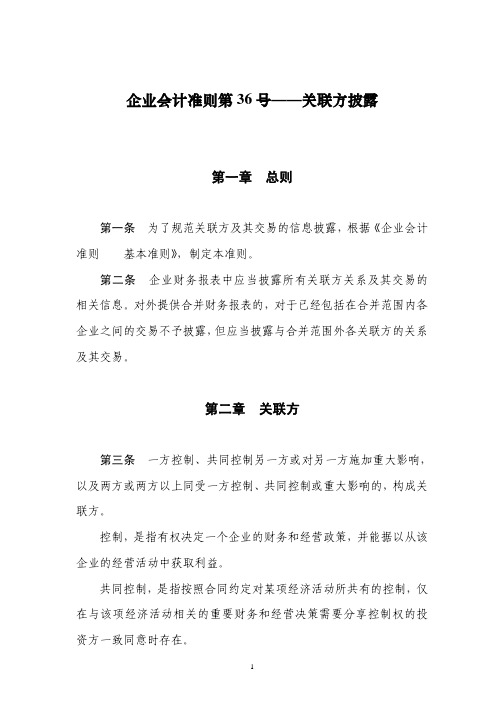
企业会计准则第36号——关联方披露第一章总则第一条为了规范关联方及其交易的信息披露,根据《企业会计准则——基本准则》,制定本准则。
第二条企业财务报表中应当披露所有关联方关系及其交易的相关信息。
对外提供合并财务报表的,对于已经包括在合并范围内各企业之间的交易不予披露,但应当披露与合并范围外各关联方的关系及其交易。
第二章关联方第三条一方控制、共同控制另一方或对另一方施加重大影响,以及两方或两方以上同受一方控制、共同控制或重大影响的,构成关联方。
控制,是指有权决定一个企业的财务和经营政策,并能据以从该企业的经营活动中获取利益。
共同控制,是指按照合同约定对某项经济活动所共有的控制,仅在与该项经济活动相关的重要财务和经营决策需要分享控制权的投资方一致同意时存在。
重大影响,是指对一个企业的财务和经营政策有参与决策的权力,但并不能够控制或者与其他方一起共同控制这些政策的制定。
第四条下列各方构成企业的关联方:(一)该企业的母公司。
(二)该企业的子公司。
(三)与该企业受同一母公司控制的其他企业。
(四)对该企业实施共同控制的投资方。
(五)对该企业施加重大影响的投资方。
(六)该企业的合营企业。
(七)该企业的联营企业。
(八)该企业的主要投资者个人及与其关系密切的家庭成员。
主要投资者个人,是指能够控制、共同控制一个企业或者对一个企业施加重大影响的个人投资者。
(九)该企业或其母公司的关键管理人员及与其关系密切的家庭成员。
关键管理人员,是指有权力并负责计划、指挥和控制企业活动的人员。
与主要投资者个人或关键管理人员关系密切的家庭成员,是指在处理与企业的交易时可能影响该个人或受该个人影响的家庭成员。
(十)该企业主要投资者个人、关键管理人员或与其关系密切的家庭成员控制、共同控制或施加重大影响的其他企业。
第五条仅与企业存在下列关系的各方,不构成企业的关联方:(一)与该企业发生日常往来的资金提供者、公用事业部门、政府部门和机构。
(二)与该企业发生大量交易而存在经济依存关系的单个客户、供应商、特许商、经销商或代理商。
国际会计准则第36号资产减值

国际会计准则第36号资产减值国际会计准则第36号(IAS36)是国际会计准则委员会(IASB)发布的关于资产减值的准则。
该准则规定了企业在制定财务报表时应如何评估和计量资产减值以及提供相关信息的要求。
本文将对国际会计准则第36号进行详细的介绍。
首先,IAS36准则规定企业需要对其资产进行减值测试。
所谓减值测试是指企业评估其资产是否有可能发生减值的过程。
减值是指资产价值低于其账面价值的情况。
资产减值测试的目的是确定资产的可收回金额,即通过该资产未来的利润能够收回的金额。
IAS36规定了两种减值测试方法:单个资产的减值测试和现金生成单位(CGU)的减值测试。
单个资产的减值测试是指对资产单独进行减值测试,而CGU的减值测试指的是对资产组合进行减值测试。
在进行减值测试时,企业需要首先根据预计利润使用未来现金流量的现值计算资产的可收回金额。
如果可收回金额低于资产的账面价值,那么该资产发生了减值,企业需要将其账面价值减记到可收回金额的水平。
对于CGU的减值测试,企业需要将其资产组合划分为独立的现金生成单位,并对每个现金生成单位进行单独的减值测试。
如果CGU的可收回金额低于其账面价值,企业需要将其账面价值减记到可收回金额的水平。
如果资产的减值无法明确地分配给特定的资产,那么企业应该将减值拨备分配到整个资产组合。
减值测试需要在特定的时间间隔内进行。
按照IAS36的规定,企业至少在每年末或在特定的事件发生时进行减值测试。
如果有迹象表明资产可能发生减值,企业也需要进行中期减值测试。
此外,IAS36也提供了有关信息披露的要求。
企业需要在财务报表中提供与资产减值相关的信息,包括资产减值拨备的变动情况、资产减值损失的计量方法等。
这些信息有助于用户了解企业的风险和潜在的减值风险。
总结起来,国际会计准则第36号规定了企业在制定财务报表时应如何评估和计量资产减值,并提供相关的信息披露要求。
减值测试是一个重要的过程,可以帮助企业评估其资产的可收回金额,确保财务报表真实反映了企业的资产价值。
企业会计准则第36号关联方披露
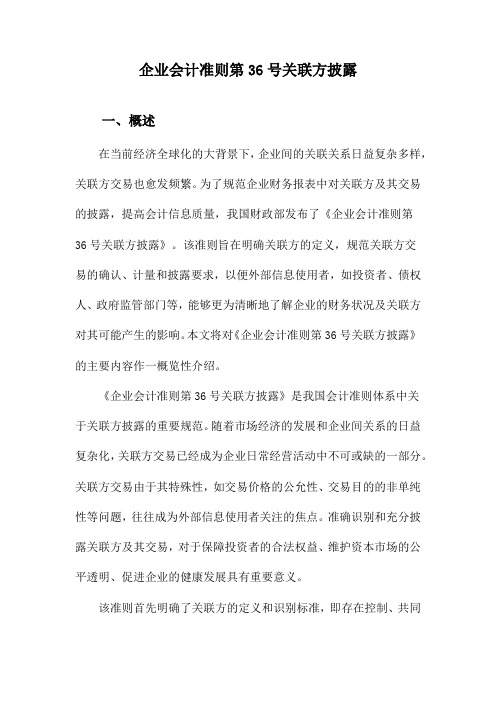
企业会计准则第36号关联方披露一、概述在当前经济全球化的大背景下,企业间的关联关系日益复杂多样,关联方交易也愈发频繁。
为了规范企业财务报表中对关联方及其交易的披露,提高会计信息质量,我国财政部发布了《企业会计准则第36号关联方披露》。
该准则旨在明确关联方的定义,规范关联方交易的确认、计量和披露要求,以便外部信息使用者,如投资者、债权人、政府监管部门等,能够更为清晰地了解企业的财务状况及关联方对其可能产生的影响。
本文将对《企业会计准则第36号关联方披露》的主要内容作一概览性介绍。
《企业会计准则第36号关联方披露》是我国会计准则体系中关于关联方披露的重要规范。
随着市场经济的发展和企业间关系的日益复杂化,关联方交易已经成为企业日常经营活动中不可或缺的一部分。
关联方交易由于其特殊性,如交易价格的公允性、交易目的的非单纯性等问题,往往成为外部信息使用者关注的焦点。
准确识别和充分披露关联方及其交易,对于保障投资者的合法权益、维护资本市场的公平透明、促进企业的健康发展具有重要意义。
该准则首先明确了关联方的定义和识别标准,即存在控制、共同控制或重大影响关系的各方。
在此基础上,要求企业在进行财务报表编制时,必须对关联方关系及其交易进行充分的披露。
这包括对企业与关联方的资金往来、采购销售等交易行为进行全面梳理和准确计量,确保信息的真实性和完整性。
准则强调了对关联交易的披露应遵循重要性原则,即对于重大关联交易应特别突出,详细阐述其经济实质和影响。
对于非重大关联交易,企业也应按照相关要求进行适当披露。
通过这样的规定,使得外部信息使用者能够更全面地了解企业的财务状况和经营成果,为他们的决策提供更准确的信息支持。
1. 阐述会计准则的重要性和作用。
会计准则是一套规范企业会计政策选择和财务报告编制的标准和原则,它在企业经营活动中发挥着至关重要的作用。
会计准则为企业的财务报告提供了清晰、一致的标准,确保了信息的准确性和可比性。
会计准则有助于保护投资者和债权人的利益,使他们在决策时能够基于可靠、透明的财务信息。
会计实务:《企业会计准则第36号--关联方披露》的主要内容
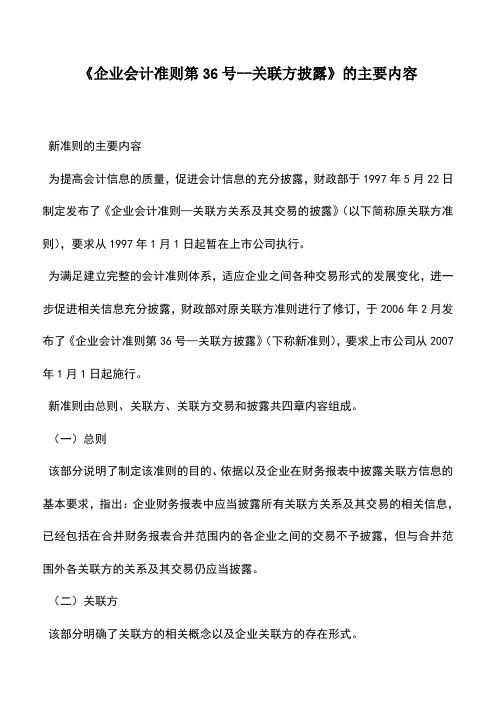
《企业会计准则第36号--关联方披露》的主要内容新准则的主要内容为提高会计信息的质量,促进会计信息的充分披露,财政部于1997年5月22日制定发布了《企业会计准则—关联方关系及其交易的披露》(以下简称原关联方准则),要求从1997年1月1日起暂在上市公司执行。
为满足建立完整的会计准则体系,适应企业之间各种交易形式的发展变化,进一步促进相关信息充分披露,财政部对原关联方准则进行了修订,于2006年2月发布了《企业会计准则第36号—关联方披露》(下称新准则),要求上市公司从2007年1月1日起施行。
新准则由总则、关联方、关联方交易和披露共四章内容组成。
(一)总则该部分说明了制定该准则的目的、依据以及企业在财务报表中披露关联方信息的基本要求,指出:企业财务报表中应当披露所有关联方关系及其交易的相关信息,已经包括在合并财务报表合并范围内的各企业之间的交易不予披露,但与合并范围外各关联方的关系及其交易仍应当披露。
(二)关联方该部分明确了关联方的相关概念以及企业关联方的存在形式。
1.相关定义:(1)关联方:一方控制、共同控制另一方或对另一方施加重大影响以及两方或两方以上同受一方控制、共同控制或重大影响的,构成关联万。
(2)控制,是指有权决定一个企业的财务和经营政策,并能据以从该企业的经营活动中获取利益。
(3)共同控制,是指按照合同约定对某项经济活动所共有的控制,仅在与该项经济活动相关的重要财务和经营决策需要分享控制权的投资方一致同意时存在。
(4)重大影响,是指对一个企业的财务和经营政策有参与决策的权力,但并不能够控制或者与其他方一起共同控制这些政策的制定。
2.企业的关联方有以下形式:(1)该企业的母公司;(2)该企业的子公司;(3)与该企业受同一母公司控制的其他企业;(4)对该企业实施共同控制的投资方;(5)对该企业施加重大影响的投资方;(6)该企业的合营企业;(7)该企业的联营企业;(g)该企业的主要投资者个人及与其关系密切的家庭成员;(9)该企业或其母公司的关键管理人员及与其关系密切的家庭成员;(10)该企业主要投资者个人、关键管理人员或与其关系密切的家庭成员控制、共同控制或施加重大影响的其他企业。
企业会计准则第36号

企业会计准则第36号
1企业会计准则第36号
企业会计准则第36号是指企业针对投资者提供相关有关财务报告的会计行为准则。
该准则要求企业在编制和报告财务信息时,应采用与现时评估相对应的会计政策和估计。
企业在报告季度和)报告发生情况时,也应采取合理的估计,以确定准确的财务报告。
2重大会计估计
企业会计准则第36号要求企业在报告财务信息时,应考虑重大会计估计。
重大会计估计是指一般企业会计准则下,企业确定相关财务报告等重大财务科目的估计值,其具有重大影响,可能导致其财务报告货币值显著偏离之评估。
重大会计估计也是会计绩效评价的最重要的因素之一。
3会计估计准则研究
为了确定适用的会计估计准则,企业应考虑不同情况下,财务信息会受报告期内可能发生各类情况或条件影响的可能性。
企业应根据可能收到的新信息,针对上述事项动态进行准则研究,适时修改会计估计准则,从而更好地反映投资者的现时利益。
4灵活运用会计准则
企业应灵活运用会计准则第36号,在报告和评价财务信息时,应相应地采用适用的会计政策和估计,以确保财务报表的真实、准确和
完整。
企业还应当审慎合理使用会计准则第36号中提供的估计功能、方法和理论,确保采取合理的会计估计,并用于准确报告报告发生情况,以提供有价值的财务信息。
会计准则第36号关联方披露
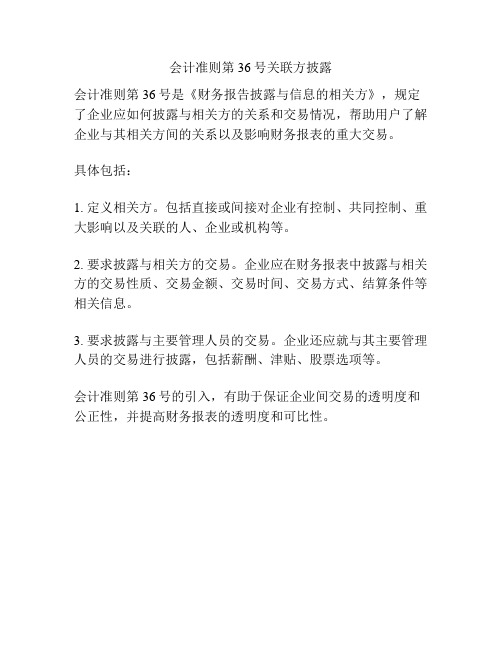
会计准则第36号关联方披露
会计准则第36号是《财务报告披露与信息的相关方》,规定了企业应如何披露与相关方的关系和交易情况,帮助用户了解企业与其相关方间的关系以及影响财务报表的重大交易。
具体包括:
1. 定义相关方。
包括直接或间接对企业有控制、共同控制、重大影响以及关联的人、企业或机构等。
2. 要求披露与相关方的交易。
企业应在财务报表中披露与相关方的交易性质、交易金额、交易时间、交易方式、结算条件等相关信息。
3. 要求披露与主要管理人员的交易。
企业还应就与其主要管理人员的交易进行披露,包括薪酬、津贴、股票选项等。
会计准则第36号的引入,有助于保证企业间交易的透明度和公正性,并提高财务报表的透明度和可比性。
企业会计准则第36号--关联方披露
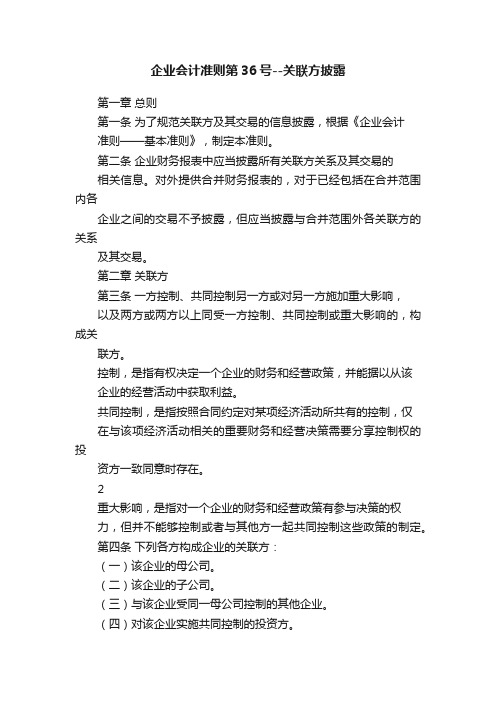
企业会计准则第36号--关联方披露第一章总则第一条为了规范关联方及其交易的信息披露,根据《企业会计准则——基本准则》,制定本准则。
第二条企业财务报表中应当披露所有关联方关系及其交易的相关信息。
对外提供合并财务报表的,对于已经包括在合并范围内各企业之间的交易不予披露,但应当披露与合并范围外各关联方的关系及其交易。
第二章关联方第三条一方控制、共同控制另一方或对另一方施加重大影响,以及两方或两方以上同受一方控制、共同控制或重大影响的,构成关联方。
控制,是指有权决定一个企业的财务和经营政策,并能据以从该企业的经营活动中获取利益。
共同控制,是指按照合同约定对某项经济活动所共有的控制,仅在与该项经济活动相关的重要财务和经营决策需要分享控制权的投资方一致同意时存在。
2重大影响,是指对一个企业的财务和经营政策有参与决策的权力,但并不能够控制或者与其他方一起共同控制这些政策的制定。
第四条下列各方构成企业的关联方:(一)该企业的母公司。
(二)该企业的子公司。
(三)与该企业受同一母公司控制的其他企业。
(四)对该企业实施共同控制的投资方。
(五)对该企业施加重大影响的投资方。
(六)该企业的合营企业。
(七)该企业的联营企业。
(八)该企业的主要投资者个人及与其关系密切的家庭成员。
主要投资者个人,是指能够控制、共同控制一个企业或者对一个企业施加重大影响的个人投资者。
(九)该企业或其母公司的关键管理人员及与其关系密切的家庭成员。
关键管理人员,是指有权力并负责计划、指挥和控制企业活动的人员。
与主要投资者个人或关键管理人员关系密切的家庭成员,是指在处理与企业的交易时可能影响该个人或受该个人影响的家庭成员。
(十)该企业主要投资者个人、关键管理人员或与其关系密切的家庭成员控制、共同控制或施加重大影响的其他企业。
第五条仅与企业存在下列关系的各方,不构成企业的关联方:(一)与该企业发生日常往来的资金提供者、公用事业部门、政府部门和机构。
(二)与该企业发生大量交易而存在经济依存关系的单个客户、3供应商、特许商、经销商或代理商。
企业会计准则第36号关联方披露解读
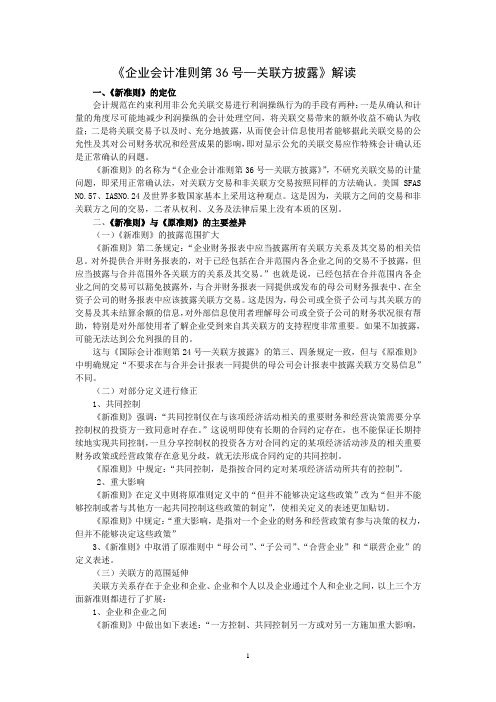
《企业会计准则第36号—关联方披露》解读一、《新准则》的定位会计规范在约束利用非公允关联交易进行利润操纵行为的手段有两种:一是从确认和计量的角度尽可能地减少利润操纵的会计处理空间,将关联交易带来的额外收益不确认为收益;二是将关联交易予以及时、充分地披露,从而使会计信息使用者能够据此关联交易的公允性及其对公司财务状况和经营成果的影响,即对显示公允的关联交易应作特殊会计确认还是正常确认的问题。
《新准则》的名称为“《企业会计准则第36号—关联方披露》”,不研究关联交易的计量问题,即采用正常确认法,对关联方交易和非关联方交易按照同样的方法确认。
美国SFAS NO.57、IASNO.24及世界多数国家基本上采用这种观点。
这是因为,关联方之间的交易和非关联方之间的交易,二者从权利、义务及法律后果上没有本质的区别。
二、《新准则》与《原准则》的主要差异(一)《新准则》的披露范围扩大《新准则》第二条规定:“企业财务报表中应当披露所有关联方关系及其交易的相关信息。
对外提供合并财务报表的,对于已经包括在合并范围内各企业之间的交易不予披露,但应当披露与合并范围外各关联方的关系及其交易。
”也就是说,已经包括在合并范围内各企业之间的交易可以豁免披露外,与合并财务报表一同提供或发布的母公司财务报表中、在全资子公司的财务报表中应该披露关联方交易。
这是因为,母公司或全资子公司与其关联方的交易及其未结算余额的信息,对外部信息使用者理解母公司或全资子公司的财务状况很有帮助,特别是对外部使用者了解企业受到来自其关联方的支持程度非常重要。
如果不加披露,可能无法达到公允列报的目的。
这与《国际会计准则第24号—关联方披露》的第三、四条规定一致,但与《原准则》中明确规定“不要求在与合并会计报表一同提供的母公司会计报表中披露关联方交易信息”不同。
(二)对部分定义进行修正1、共同控制《新准则》强调:“共同控制仅在与该项经济活动相关的重要财务和经营决策需要分享控制权的投资方一致同意时存在。
国际会计准则解读与应用案例分析
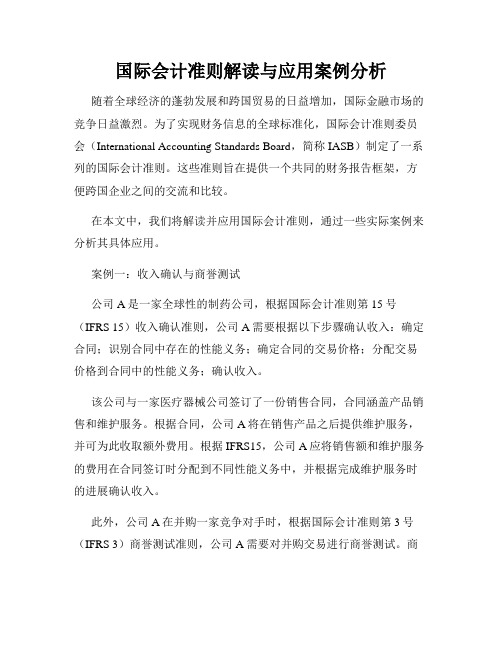
国际会计准则解读与应用案例分析随着全球经济的蓬勃发展和跨国贸易的日益增加,国际金融市场的竞争日益激烈。
为了实现财务信息的全球标准化,国际会计准则委员会(International Accounting Standards Board,简称IASB)制定了一系列的国际会计准则。
这些准则旨在提供一个共同的财务报告框架,方便跨国企业之间的交流和比较。
在本文中,我们将解读并应用国际会计准则,通过一些实际案例来分析其具体应用。
案例一:收入确认与商誉测试公司A是一家全球性的制药公司,根据国际会计准则第15号(IFRS 15)收入确认准则,公司A需要根据以下步骤确认收入:确定合同;识别合同中存在的性能义务;确定合同的交易价格;分配交易价格到合同中的性能义务;确认收入。
该公司与一家医疗器械公司签订了一份销售合同,合同涵盖产品销售和维护服务。
根据合同,公司A将在销售产品之后提供维护服务,并可为此收取额外费用。
根据IFRS15,公司A应将销售额和维护服务的费用在合同签订时分配到不同性能义务中,并根据完成维护服务时的进展确认收入。
此外,公司A在并购一家竞争对手时,根据国际会计准则第3号(IFRS 3)商誉测试准则,公司A需要对并购交易进行商誉测试。
商誉是超过合理价值的支付金额,其中包括未能在资产和负债中识别的无形资产。
案例二:金融工具和关联方交易公司B是一家跨国投资公司,其主要业务是投资金融工具和参与关联方交易。
根据国际会计准则第9号(IFRS 9)金融工具准则,公司B 需要对其投资的金融工具进行分类和计量。
该准则根据金融资产的特性和管理意图,将其分为可供出售金融资产、持有至到期的金融资产和以公允价值计量且其变动计入损益的金融资产。
此外,公司B还需要根据国际会计准则第24号(IFRS 24)关联方交易准则揭示与关联方的交易和关系。
该准则要求公司B披露其在报表日期的关联方交易的性质、类型和金额,以及与关联方交易相关的任何重大风险和控制措施。
企业会计准则第36号――关联方披露
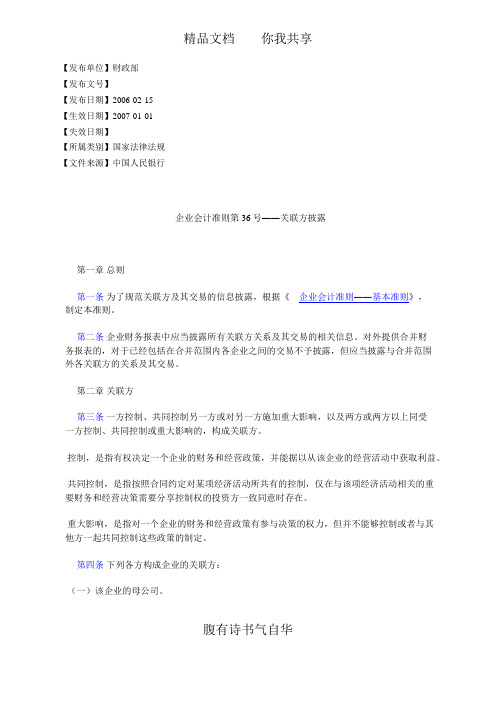
【发布单位】财政部【发布文号】【发布日期】2006-02-15【生效日期】2007-01-01【失效日期】【所属类别】国家法律法规【文件来源】中国人民银行企业会计准则第36号――关联方披露第一章总则第一条为了规范关联方及其交易的信息披露,根据《企业会计准则――基本准则》,制定本准则。
第二条企业财务报表中应当披露所有关联方关系及其交易的相关信息。
对外提供合并财务报表的,对于已经包括在合并范围内各企业之间的交易不予披露,但应当披露与合并范围外各关联方的关系及其交易。
第二章关联方第三条一方控制、共同控制另一方或对另一方施加重大影响,以及两方或两方以上同受一方控制、共同控制或重大影响的,构成关联方。
控制,是指有权决定一个企业的财务和经营政策,并能据以从该企业的经营活动中获取利益。
共同控制,是指按照合同约定对某项经济活动所共有的控制,仅在与该项经济活动相关的重要财务和经营决策需要分享控制权的投资方一致同意时存在。
重大影响,是指对一个企业的财务和经营政策有参与决策的权力,但并不能够控制或者与其他方一起共同控制这些政策的制定。
第四条下列各方构成企业的关联方:(一)该企业的母公司。
腹有诗书气自华(二)该企业的子公司。
(三)与该企业受同一母公司控制的其他企业。
(四)对该企业实施共同控制的投资方。
(五)对该企业施加重大影响的投资方。
(六)该企业的合营企业。
(七)该企业的联营企业。
(八)该企业的主要投资者个人及与其关系密切的家庭成员。
主要投资者个人,是指能够控制、共同控制一个企业或者对一个企业施加重大影响的个人投资者。
(九)该企业或其母公司的关键管理人员及与其关系密切的家庭成员。
关键管理人员,是指有权力并负责计划、指挥和控制企业活动的人员。
与主要投资者个人或关键管理人员关系密切的家庭成员,是指在处理与企业的交易时可能影响该个人或受该个人影响的家庭成员。
(十)该企业主要投资者个人、关键管理人员或与其关系密切的家庭成员控制、共同控制或施加重大影响的其他企业。
企业会计准则第36号(关联方披露)

企业会计准则第36号(关联⽅披露)企业会计准则第36号——关联⽅披露(2006)财会[2006]3号颁布时间:2006-2-15发⽂单位:财政部第⼀章总则第⼀条为了规范关联⽅及其交易的信息披露,根据《企业会计准则——基本准则》,制定本准则。
第⼆条企业财务报表中应当披露所有关联⽅关系及其交易的相关信息。
对外提供合并财务报表的,对于已经包括在合并范围内各企业之间的交易不予披露,但应当披露与合并范围外各关联⽅的关系及其交易。
第⼆章关联⽅第三条⼀⽅控制、共同控制另⼀⽅或对另⼀⽅施加重⼤影响,以及两⽅或两⽅以上同受⼀⽅控制、共同控制或重⼤影响的,构成关联⽅。
控制,是指有权决定⼀个企业的财务和经营政策,并能据以从该企业的经营活动中获取利益。
共同控制,是指按照合同约定对某项经济活动所共有的控制,仅在与该项经济活动相关的重要财务和经营决策需要分享控制权的投资⽅⼀致同意时存在。
重⼤影响,是指对⼀个企业的财务和经营政策有参与决策的权⼒,但并不能够控制或者与其他⽅⼀起共同控制这些政策的制定。
第四条下列各⽅构成企业的关联⽅:(⼀)该企业的母公司。
(⼆)该企业的⼦公司。
(三)与该企业受同⼀母公司控制的其他企业。
(四)对该企业实施共同控制的投资⽅。
(五)对该企业施加重⼤影响的投资⽅。
(六)该企业的合营企业。
(七)该企业的联营企业。
(⼋)该企业的主要投资者个⼈及与其关系密切的家庭成员。
主要投资者个⼈,是指能够控制、共同控制⼀个企业或者对⼀个企业施加重⼤影响的个⼈投资者。
(九)该企业或其母公司的关键管理⼈员及与其关系密切的家庭成员。
关键管理⼈员,是指有权⼒并负责计划、指挥和控制企业活动的⼈员。
与主要投资者个⼈或关键管理⼈员关系密切的家庭成员,是指在处理与企业的交易时可能影响该个⼈或受该个⼈影响的家庭成员。
(⼗)该企业主要投资者个⼈、关键管理⼈员或与其关系密切的家庭成员控制、共同控制或施加重⼤影响的其他企业。
第五条仅与企业存在下列关系的各⽅,不构成企业的关联⽅:(⼀)与该企业发⽣⽇常往来的资⾦提供者、公⽤事业部门、政府部门和机构。
外文翻译--国际会计准则第36号-资产减值

外文翻译--国际会计准则第36号-资产减值本科毕业论文(设计)外文翻译外文题目 International Accounting Standard 36外文出处 International Accounting Standard原文:International Accounting Standard 36 Impairment of AssetsObjective1. The objective of this Standard is to prescribe the procedures that an entity applies to ensure that its assets are carried at no more than their recoverable amount. An asset is carried at more than its recoverable amount if its carrying amount exceeds the amount to be recovered through use or sale of the asset. If this is the case, the asset is described as impaired and the Standard requires the entity to recognise an impairment loss. The Standard also specifies when an entity should reverse an impairment loss and prescribes disclosures.Scope2. This Standard shall be applied in accounting for the impairment of all assets, other than:a inventories see IAS 2 Inventories ;b assets arising from construction contracts see IAS 11 Construction Contracts ;c deferred tax assets see IAS 12 Income Taxes ;d assets arising from employee benefits see IAS 19 Employee Benefits ;e financial assets that are within the scope of IAS 32 Financial Instruments.f investment property that is measured at fair value see IAS 40 Investment Property ;g biological assets related to agricultural activity that are measured at fair value less costs to sell see IAS 41 Agriculture ;h deferred acquisition costs, and intangible assets, arising from an insurer’s contractual r ights under insurance contracts within the scope of IFRS 4 Insurance Contracts; andi non-current assets or disposal groups classified as held for sale in accordance with IFRS 5 Non-current Assets Held for Sale and Discontinued Operations.3. This Standard does not apply to inventories, assets arising from construction contracts, deferred tax assets, assets arising from employee benefits, or assets classified as held for sale or included in a disposal group that is classified as held for sale, because existing IFRSs applicable to these assets contain requirements for recognising andmeasuring these assets.4. This Standard applies to financial assets classified as:a subsidiaries, as defined in IAS 27 Consolidated and Separate Financial Statements;b associates, as defined in IAS 28 Investments in Associates; andc joint ventures, as defined in IAS 31 Interests in Joint Ventures.For impairment of other financial assets, refer to IAS 39.5. This Standard does not apply to financial assets within the scope of IFRS 9, investment property measured at fair value in accordance with IAS 40, or biological assets related to agricultural activity measured at fair value less costs to sell in accordance with IAS 41. However, this Standard applies to assets that are carried at revalued amount ie fair value in accordance with other IFRSs, such as the revaluation model in IAS 16 Property, Plant and Equipment. Identifying whether a revalued asset may be impaired depends on the basis used to determine fair value:a if the asset’s fair value is its market value, the only difference between the asset’s fair value and its fair value less costs to sell is the direct incremental costs to dispose of the asset:i if the disposal costs are negligible, the recoverable amount of the revalued asset is necessarily close to, or greater than, its revalued amount ie fair value . In this case, after the revaluation requirements have been applied, it is unlikely that the revalued asset is impaired andrecoverable amount need not be estimated.ii if the disposal costs are not negligible, the fair value less costs to sell of the revalued asset is necessarily less than its fair value. Therefore, the revalued asset will be impaired if its value in use is less than its revalued amount ie fair value . In this case, after the revaluation requirements have been applied, an entity applies this Standard to determine whether the asset may be impaired.b if the asset s fair value is determined on a basis other than its market value,its revalued amount ie fair value may be greater or lower than its recoverable amount. Hence, after the revaluation requirements have been applied, an entity applies this Standard to determine whether the asset may be impaired.Definitions6. The following terms are used in this Standard with the meanings specified:Carrying amount is the amount at which an asset is recognised after deducting any accumulated depreciation amortisation and accumulated impairment losses thereon.A cash-generating unit is the smallest identifiable group of assets that generates cash inflows that are largely independent of the cash inflows from other assets or groups of assets.Corporate assets are assets other than goodwill that contribute tothe future cash flows of both the cash-generating unit under review and other cash-generating units.Costs of disposal are incremental costs directly attributable to the disposal of an asset or cash-generating unit, excluding finance costs and income tax expense.Depreciable amount is the cost of an asset, or other amount substituted for cost in the financial statements, less its residual value.Depreciation Amortisation is the systematic allocation of the depreciable amount of an asset over its useful life.Fair value less costs to sell is the amount obtainable from the sale of an asset or cash-generating unit in an arm’s length transaction between knowledgeable, willing parties, less the costs of disposal.An impairment loss is the amount by which the carrying amount of an asset or a cash-generating unit exceeds its recoverable amount.The recoverable amount of an asset or a cash-generating unit is the higher of its fair value less costs to sell and its value in use.Useful life is either:a the period of time over which an asset is expected to be used by the entity; orb the number of production or similar units expected to be obtained from the asset by the entity.Value in use is the present value of the future cash flows expectedto be derived from an asset or cash-generating unit.Identifying an asset that may be impaired7. Paragraphs 8 17 specify when recoverable amount shall be determined. These requirements use the term ‘an asset’ but apply equally to an individual asset or a cash-generating unit. The remainder of this Standard is structured as follows:a paragraphs 18 57 set out the requirements for measuring recoverable amount. These requirements also use the term ‘an asset’ but apply equally to an individual asset and a cash-generating unit.b paragraphs 58 108 set out the requirements for recognising and measuring impairment losses. Recognition and measurement of impairment losses for individual assets other than goodwill are dealt with in paragraphs 58 64.Paragraphs 65 108 deal with the recognition and measurement of impairment losses for cash-generating units and goodwill.In the case of an intangible asset, the term ‘amortisation’ is generally used instead of ‘depreciation’. The two terms have the same meaning.c paragraphs 109 116 set out the requirements for reversing an impairment loss recognised in prior periods for an asset or a cash-generating unit. Again, these requirements use the term ‘an asset’ but apply equally to an individual asset or a cash-generating unit.Additional requirements for an individual asset are set out in paragraphs 117 121, for a cash-generating unit in paragraphs 122 and 123, and for goodwill in paragraphs 124 and 125.d paragraphs 126 133 specify the information to be disclosed about impairment losses and reversals of impairment losses for assets and cash-generating units. Paragraphs 134 137 specify additional disclosure requirements for cash-generating units to which goodwill or intangible assets with indefinite useful lives have been allocated for impairment testing purposes.8. An entity shall assess at the end of each reporting period whether there is any indication that an asset may be impaired. If any such indication exists, the entity shall estimate the recoverable amount of the asset.9. In assessing whether there is any indication that an asset may be impaired, an entity shall consider, as a minimum, the following indications:External sources of informationa during the period, an asset’s market value has declined significantly more than would be expected as a result of the passage of time or normal use;b significant changes with an adverse effect on the entity have taken place during the period, or will take place in the near future, inthe technological, market, economic or legal environment in which the entity operates or in the market to which an asset is dedicated;c market interest rates or other market rates of return on investments have increased during the period, and those increases are likely to affect the discount rate used in calculating an asset’s value in use and decrease the asset’s recoverable amount materially;d the carrying amount of the net assets of the entity is more than its market capitalisation.Internal sources of informatione evidence is available of obsolescence or physical damage of an asset.f significant changes with an adverse effect on the entity have taken place during the period, or are expected to take place in the near future, in the extent to which, or manner in which, an asset is used or is expected to be used. These changes include the asset becoming idle, plans to discontinue or restructure the operation to which an asset belongs, plans to dispose of an asset before the previously expected date, and reassessing the useful life of an asset as finite rather than indefinite.g evidence is available from internal reporting that indicates that the economic performance of an asset is, or will be, worse than expected.10. The list in paragraph 9 is not exhaustive. An entity may identifyother indications that an asset may be impaired and these would also require the entity to determine the asset’s recoverable amount.13 Evidence from internal reporting that indicates that an asset may be impaired includes the existence of:a cash flows for acquiring the asset, or subsequent cash needs for operating or maintaining it, that are significantly higher than those originally budgeted;b actual net cash flows or operating profit or loss flowing from the asset that are significantly worse than those budgeted;c a significant decline in budgeted net cash flows or operating profit, or a significant increase in budgeted loss, flowing from the asset;d operating losses or net cash outflows for the asset, when current period amounts are aggregated with budgeted amounts for the future.12. The concept of materiality applies in identifying whether the recoverable amount of an asset needs to be estimated. For example, if previous calculations show that an asset’ s recoverable amount is significantly greater than its carrying amount, the entity need not re-estimate the asset’ s recoverable amount if no events have occurred that would eliminate that difference. Similarly, previous analysis may show that an asset’s recoverable amount is not sensitive to one or more of the indications listed in paragraph 9.13 As an illustration of paragraph 12, if market interest rates or other market rates of return on investments have increased during the period, an entity is not required to make a formal estimate of an asset’ s recoverable amount in the following cases:a if the discount rate used in calculating the asset’ s value in use is unlikely to be affected by the increase in these market rates. For example, increases in short-term interest rates may not have a material effect on the discount rate used for an asset that has a long remaining useful life; orb if the discount rate used in calculating the asset’ s value in use is likely to be affected by the increase in these market rates but previous sensitivity analysis of recoverable amount shows that:i it is unlikely that there will be a material decrease in recoverable amount because future cash flows are also likely to increase eg in some cases, an entity may be able to demonstrate that it adjusts its revenues to compensate for any increase in market rates ; or ii the decrease in recoverable amount is unlikely to result in a material impairment loss.14. If there is an indication that an asset may be impaired, this may indicate that the remaining useful life, the depreciation amortisation method or the residual value for the asset needs to be reviewed and adjusted in accordance with the Standard applicable to the asset, evenif no impairment loss is recognised for the asset.From:IAS36,Impairment of Assets[S].译文:《国际会计准则第36号-资产减值》目的本准则的目的是,规定企业用以确保其资产以不超过可收回价值的金额进行计量的程序。
国际会计准则第36号资产减值
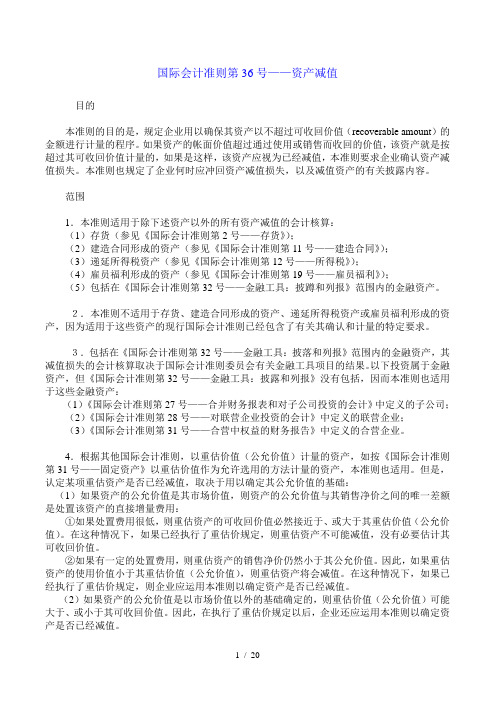
国际会计准则第36号——资产减值目的本准则的目的是,规定企业用以确保其资产以不超过可收回价值(recoverable amount)的金额进行计量的程序。
如果资产的帐面价值超过通过使用或销售而收回的价值,该资产就是按超过其可收回价值计量的,如果是这样,该资产应视为已经减值,本准则要求企业确认资产减值损失。
本准则也规定了企业何时应冲回资产减值损失,以及减值资产的有关披露内容。
范围1.本准则适用于除下述资产以外的所有资产减值的会计核算:(1)存货(参见《国际会计准则第2号——存货》);(2)建造合同形成的资产(参见《国际会计准则第11号——建造合同》);(3)递延所得税资产(参见《国际会计准则第12号——所得税》);(4)雇员福利形成的资产(参见《国际会计准则第19号——雇员福利》);(5)包括在《国际会计准则第32号——金融工具:披蹲和列报》范围内的金融资产。
2.本准则不适用于存货、建造合同形成的资产、递延所得税资产或雇员福利形成的资产,因为适用于这些资产的现行国际会计准则已经包含了有关其确认和计量的特定要求。
3.包括在《国际会计准则第32号——金融工具:披落和列报》范围内的金融资产,其减值损失的会计核算取决于国际会计准则委员会有关金融工具项目的结果。
以下投资属于金融资产,但《国际会计准则第32号——金融工具:披露和列报》没有包括,因而本准则也适用于这些金融资产:(1)《国际会计准则第27号——合并财务报表和对子公司投资的会计》中定义的子公司;(2)《国际会计准则第28号——对联营企业投资的会计》中定义的联营企业;(3)《国际会计准则第31号——合营中权益的财务报告》中定义的合营企业。
4.根据其他国际会计准则,以重估价值(公允价值)计量的资产,如按《国际会计准则第31号——固定资产》以重估价值作为允许选用的方法计量的资产,本准则也适用。
但是,认定某项重估资产是否已经减值,取决于用以确定其公允价值的基础:(1)如果资产的公允价值是其市场价值,则资产的公允价值与其销售净价之间的唯一差额是处置该资产的直接增量费用:①如果处置费用很低,则重估资产的可收回价值必然接近于、或大于其重估价值(公允价值)。
- 1、下载文档前请自行甄别文档内容的完整性,平台不提供额外的编辑、内容补充、找答案等附加服务。
- 2、"仅部分预览"的文档,不可在线预览部分如存在完整性等问题,可反馈申请退款(可完整预览的文档不适用该条件!)。
- 3、如文档侵犯您的权益,请联系客服反馈,我们会尽快为您处理(人工客服工作时间:9:00-18:30)。
国际会计准则第号资产减值
国际会计准则第号
目的
本准则的目的是,规定企业用以确保其资产以不超过可收回价值()的金额进行计量的程序。
如果资产的帐面价值超过通过使用或销售而收回的价值,该资产就是按超过其可收回价值计量的,如果是这样,该资产应视为已经减值,本准则要求企业确认资产减值损失。
本准则也规定了企业何时应冲回资产减值损失,以及减值资产的有关披露内容。
范围
.本准则适用于除下述资产以外的所有资产减值的会计核算:
()存货(参见《国际会计准则第号存货》);
()建造合同形成的资产(参见《国际会计准则第号建造合同》);
()递延所得税资产(参见《国际会计准则第号所得税》);
()雇员福利形成的资产(参见《国际会计准则第号雇员福利》);
()包括在《国际会计准则第号金融工具:披蹲和列报》范围内的金融资产。
.本准则不适用于存货、建造合同形成的资产、递延所得税资产或雇员福利形成的资产,因为适用于这些资产的现行国际会计准则已经包含了有关其确认和计量的特定要求。
.包括在《国际会计准则第号金融工具:披落和列报》范围内的金融资产,其减值损失的会计核算取决于国际会计准则委员会有关金融工具项目的结果。
以下投资属于金融资产,但《国际会计准则第号金融工具:披露和列报》没有包括,因而本准则也适用于这些金融资产:
()《国际会计准则第号合并财务报表和对子公司投资的会计》中定义的子公司;
()《国际会计准则第号对联营企业投资的会计》中定义的联营企业;
()《国际会计准则第号合营中权益的财务报告》中定义的合营企业。
.根据其他国际会计准则,以重估价值(公允价值)计量的资产,如按《国际会计准则第号固定资产》以重估价值作为允许选用的方法计量的资产,本准则也适用。
但是,认定某项重估资产是否已经减值,取决于用以确定其公允价值的基础:
()如果资产的公允价值是其市场价值,则资产的公允价值与其销售净价之间的唯一差额是处置该资产的直接增量费用:
①如果处置费用很低,则重估资产的可收回价值必然接近于、或大于其重估价值(公允价值)。
在这种情况下,如果已经执行了重估价规定,则重估资产不可能减值,没有必要估计其可收回价值。
②如果有一定的处置费用,则重估资产的销售净价仍然小于其公允价值。
因此,如果重估资产的使用价值小于其重估价值(公允价值),则重估资产将会减值。
在这种情况下,如果已经执行了重估价规定,则企业应运用本准则以确定资产是否已经减值。
()如果资产的公允价值是以市场价值以外的基础确定的,则重估价值(公允价值)可能大于、或小于其可收回价值。
因此,在执行了重估价规定以后,企业还应运用本准则以确定资产是否已经减值。
定义
.本准则所使用的术语,定义如下:
可收回价值,指资产的销售净价与其使用价值二者之中的较高者。
使用价值(),指预期从资产的持续使用和使用期限结束时的处置中形成的估计未来现金流量的现值。
销售净价,指在熟悉情况的交易各方之间自愿进行的正常交易中,通过销售资产而取得的、扣除处置费用后的金额。
处置费用,指可直接归属于资产处置的增量费用,不包括融资费用和所得税费用。
减值损失,指资产的帐面价值超过其可收回价值的差额。
帐面价值,指在资产负债表中确认的、扣除累计折旧(摊销)和累计减值损失后的资产价值。
折旧(摊销),指资产的可折旧金额在其使用期限内所进行的系统分配。
可折旧金额,指财务报表中资产的成本或替代成本的其他金额,扣除残值后的金额。
使用期限,指
()资产预期为企业所使用的期间;或
()企业预期可从资产中获得的产品数量或类似产品数量的单位。
现金产出单位(),指从持续使用中产生现金流入的最小的可辨认资产组合,而该资产组合的持续使用很大程度上独立于其他资产或资产组合。
总部资产(),指有助于评估中的现金产出单位和其他现金产出单位产生未来现金流量的、除商誉之外的资产。
